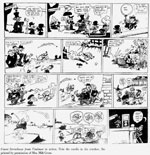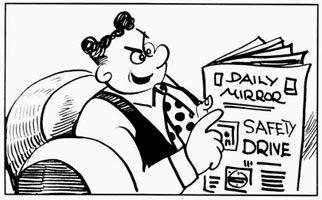Milt Gross
Banana Oil and the First
Graphic Novel?
With his characters’ ludicrously bug-eyed bulb-nosed physiognomy, sausage-fingered hands and flat feet, Milt Gross may be said in his drawing style to epitomize “cartooning.” In his life, he was creative profusion incarnate, producing not only a gaggle of comic strips but several risible prose works and, as the piece de resistance, a tome that some have dubbed the first so-called graphic novel.
Gross was born March 4, 1895 in New York City, the son of
Samuel Gross and Rose Spivak. He grew
up in the Bronx and had one-and-a-half years of secondary schooling in Kearney,
New Jersey, before leaving formal education at the age of sixteen to take a job
as an office boy in the art department of William Randolph Hearst’s New York American. The bull pen denizens for whom young Gross
did chores included Harry Hershfeld, Gus Mager, Walter Hoban, Tom McNamara,
Cliff Sterrett, Winsor McCay, and Thomas Aloysius Dorgan, who signed his
cartoons “Tad” and who called Gross “Davenport” because the youth idolized the
work of editorial cartoonist Homer Davenport. Gross, who at an early age had demonstrated an artistic bent, was in his
element, and he was often able to put his pen to good use: “I used to ghost for artists who were late
with their assignments,” he told Martin Sheridan in Comics and Their Creators. Then in November 1912, he signed his own
comic strip, his first, Jack Bull.
In 1913, Gross found a position as staff artist for the
American Press Association, and two years later, he was back with Hearst, this
time at the Evening Journal, for
which he created his first comic strip, Henry
Peck, A Happy Married Man, which was eventually syndicated by Hearst’s King
Features in 1917. Like most newspaper
staff cartoonists at the time, Gross concocted a variety of cartoon features
for his paper, some of which lasted only a few installments before yielding
their place to his next creation. For
the sports section, he did a strip called Phool
Phan Phables and, later, Sportograms. He also produced Izzy Human and Kinney B.
Alive and And Then the Fun Began—each
an instance of the typically short-lived genre of the day. In 1917, after a salary dispute, he left
Hearst and joined the Barre-Bowers Animation
Studio, which produced Mutt
and Jeff animated cartoons. His tenure
there was interrupted by service in the U.S. Expeditionary Force with the
Seventh Division in France during World War I. After the war, Gross went back to animation at the Bray Studios, and in
1920, he married Anna Abramson; they had three sons.
By 1922, Gross had returned to newspaper cartooning in
the art department of the New York World where he produced his most celebrated creations. Following the usual pattern, he again drew an assortment of features,
most based upon catch phrases. Some
lasted longer than others: Bimbo started in June 1922 and lasted
until September, after which, Gross replaced it with Babbling Brooks, which ran through February 1923 before being
supplanted by Toy Town Tots from
April until November.
During this period, he also began writing and
illustrating with comic drawings a column called Gross Exaggerations. Many
of the column’s installments concerned the dilemmas of daily life in an
imaginary Lower East Side apartment building where Mrs. Feitlebaum exchanges
gossip with her neighbors. Written in a
highly inventive Yiddish dialect, the conversations of the residents wander
from sympathetic analysis of the husband next door (“sotch a hanpacked poison”)
to discussions about the scion of another family who got caught in the
“undertone” at “Coney Highland” or the unfortunate couple that bought a cottage
with “sudden exposure.” In a fourth
floor apartment is a “nize baby” who must be seduced into eating dinner by
parents’ telling “ferry tails.” All of which Gross reported in exhaustive
detail, complete with blundering grammar and hilarious malapropisms. A collection of pieces from the column was
published in 1926 as Nize Baby, and
its enthusiastic reception was followed that year by the publication of Hiawatta Witt No Odder Poems, Gross’s
Yiddish dialect version of the Longfellow classic—a “parody which went beyond
parody into the realm of jolting laughter,” according to Stephan Becker in Comic Art in America. It was “a poetic
triumph,” Becker said, to which “the author’s inspired drawings added the final
lunatic note.”
Nize Baby’s success encouraged Gross to produce a Sunday comic strip with the same
title. Starting in September 1926, it
had run its course by February 1929, and Gross replaced it with his comic strip
masterpiece, Count Screwloose from
Tooloose, a weekly morality play about the prevailing insanity of the world
at large. Every Sunday, Count
Screwloose escapes from the Nuttycrest asylum, observes humanity in action, and
returns to Nuttycrest, which he now perceives as a safe—and sane—haven. In the last panel of every installment, the
Count rejoices at his lucky reinstatement with a dog named Iggy (who thinks
himself to be Napoleon): “Iggy, keep an
eye on me,” the Count sings out gleefully. 
Although the formula was trite (“the old joke about the
escapee who returned voluntarily,” as Becker observes), Gross endowed its
weekly repetition with the comic genius of his graphic imagination and made it
“more than just a variation on a theme.” The Count is dapper but diminutive,
less than half the size of the other characters, and in drawing his pint-sized
protagonist, Gross crossed his goggle-eyed orbs, giving him the wildly comedic
aspect that virtually defines “comic strip character.” The rest of the cast partakes of the same
tradition, resulting in a strip of almost manic ambiance, which Gross enhanced
with fast-paced action and a few doses of slapstick. The cartoonist’s inventive prowess is further displayed in the
variety of
ways he engineered the
Count’s weekly escape: an inmate raps a
hammer on one end of a teeter-tottering plank and the Count, seated on the
other end, is propelled over the wall; the Count traps the hot air of a
visiting politician in a balloon and floats over the wall, clinging to the
balloon. At the top of the Count Screwloose Sunday page appeared
another Gross concoction, Banana Oil, which took its title from the imprecation invariably shouted in the last panel
as comic indictment of some minor fraud or misapprehension being perpetrated
elsewhere in the strip; it became a popular expression, the equivalent of
“baloney.” In October 1930, on the eve
of the World’s collapse, Banana Oil was replaced by a revived Babbling Brooks, which continued into
the next year. Count Screwloose continued until May 31, 1931, after which it was syndicated by King Features.
Gross continued to write books in the same vein as his
1926 volumes: in 1927, De Night in De Front from Chreesmas and Dunt Esk; in 1928, Famous Fimmales witt Odder Ewents from Heestory; and then in 1930, He Done Her Wrong, a pictorial novel
without words—perhaps, even, a “graphic novel.” Calling it Gross’s “graphic
masterpiece,” Becker describes it as “a silent film transferred to paper.” In his method, Gross was perhaps inspired by
the recent work of a wood engraver named Lynd Ward, who, in 1929, had published God’s Man, a wordless novel-length
cautionary tale. (Ward, in turn, had probably seen similar silent pictorial
novels by a Belgian artist, Frans Masereel.) For his subject, however, Gross
relied upon his experiences in the film colony where he had worked briefly with
Charlie Chaplin on “The Circus” (released in 1928): the novel mocks the grand
passions and stock situations of Hollywood adventure films and the stage
melodramas of the 1890s with its numerous homicides and chases, not to mention
its dastardly villain, brave hero, and pure heroine. Dover reprinted the book in
1963 and Abbeville in 1983, both, Paul Karasik tells us, with an “inexplicable”
new title, Hearts of Gold. Both also
excised a few politically incorrect pages involving an African-American—“a
blackface gag,” Craig Yoe calls it, which has been restored in the 2005
carefully wrought reprint from Fantagraphics with an Introduction by Yoe and an
Appreciation by Karasik.
The World merged with the New York Telegram in
February 1931, and Gross joined Hearst’s King Features Syndicate, creating Dave’s Delicatessen, a daily and Sunday
strip of comedic continuity about the family and business of a delicatessen
owner. The strip often ended with an
extraneous panel in which a small boy observes his father at some nefarious
activity and proclaims joyfully: “That’s My Pop!” The youth’s
pride is not at all affected by the obvious fact that his father is usually
portrayed as wholly incompetent. This
panel eventually became a stand-alone feature in about 1935; entitled Grossly Xaggerated, it was usually
called by the expression that had become a catch word, “That’s My Pop!” The feature inspired a radio program of the
same name in the 1940s.
At various intervals during the thirties, Gross lived in
Hollywood, where he resumed writing scenarios for movies, but in 1934, he was
back in New York at the Mirror, for
which he created the short-lived comic strip Otto and Blotto. He also
wrote magazine articles and more humorous books in Yiddish dialect in addition
to screenplays; he was a frequent guest on radio programs and often served as
master of ceremonies at formal occasions. In 1945, he suffered a heart attack and reduced his activity; he died
November 28, 1953, of a second attack while returning to his California home
from a Hawaiian vacation.
Drawing in a style that exemplified “cartooning,” Gross
was nonetheless an original, a talent without predecessor or successful
imitator. Becker reports that he was a
man “who combined a brilliant career with absolute honesty and generosity to
all men. No ego, no tantrums, no feuds. Just Milt Gross.” When the National Cartoonists Society established a fund
for the relief of indigent
cartoonists, it was named the Milt Gross Fund as a mark of the profession’s
enduring regard.
Bibliography. Milt Gross’s life and career
receives fullest treatment in Stephan Becker’s Comic Art in America (1959), pp.366-374. Other books in which Gross receives more than token treatment are A History of American Graphic Humor,
1865-1938, Vol. 2, by William C. Murrell (1967), Comics and Their Creators by Martin Sheridan (1944) and The Encyclopedia of American Comics by
Ron Goulart (1990). Gross’s books not
mentioned in the foregoing include: What’s This? (1936), Dear Dollink (1944), and Shoulda Ate the Eclair (1946); his
illustrations appear in Margaret Linden’s Pasha
the Persian (1936).
More cartooner biographies? They appear in profusion, somewhat shorter than
the
foregoing, in Harv’s Gallery of Rogues,
a preview of which appears here. For Harv’s other books, click here to be transported to the page where their covers are displayed (from whence,
you can journey to previews of each).

